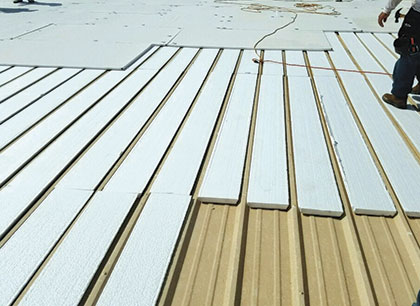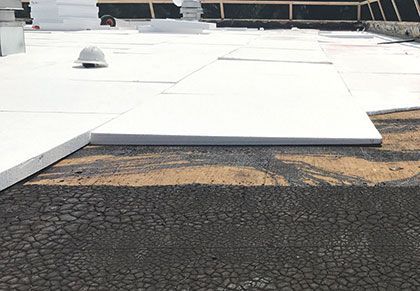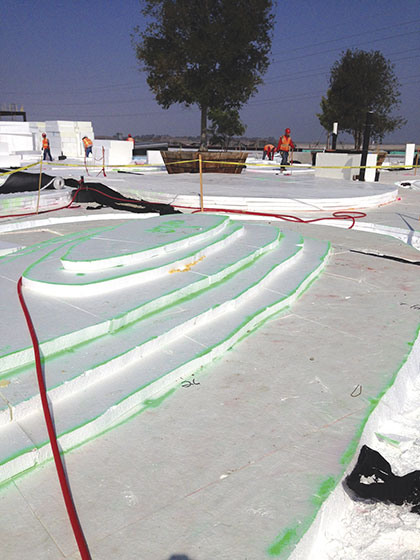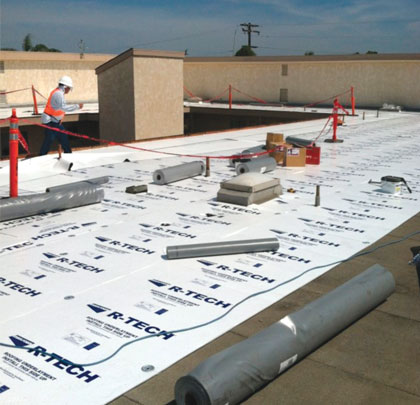EPS fan-fold insulation bundles are easy to carry and quickly unfold to cover up to 2 squares with a single bundle.
Compared to other parts of the building envelope, insulating the roof has the added challenge of needing to transport materials and workers to the rooftop. To reduce the time and cost of installing roof insulation, it is important to use products that install easily and with minimal waste—getting workers off the roof as quickly as possible, while still providing an energy-efficient assembly.
Insulation manufacturers have developed a number of products that streamline insulating the roof. Among these are specialized expanded polystyrene (EPS) insulation products, which provide outstanding moisture performance and stable long-term R-values. From fanfold bundles to flute-fill products, tapered insulation and more, EPS insulation helps contractors save on material and labor costs.
The following points are four practical ways to help save tens of thousands of dollars, or more, on commercial building roof insulation, depending on your job’s size.
ROOF RECOVERS
An easy-to-use insulation option for roof recovers is EPS panels pre-folded into bundles, with polymeric facers on both sides. Products like R-TECH FF (fanfold) are available in standard sizes up to 200 square feet, comprised of 25 panels that are 2 feet by 4 feet each, and come in various thicknesses. A typical two-square bundle weighs less than 11 pounds, so it is easy for one person to carry.
EPS fanfold bundles require fewer fasteners per square foot than most roofing insulations, and are less expensive than virtually every recover board. The man-hours needed to install fanfold bundles are about 60 percent less than working with individual sheets. Material costs are also lower than wood fiber, perlite, or gypsum board. On large projects, the total savings can add up to tens of thousands of dollars.

EPS flute fill insulation is factory-cut to fit any metal roof flange profile.
METAL ROOF RECOVERS
For metal roof recovers, the standing seams of the metal roofing add a level of complexity for crews to work around to establish a smooth surface for the new roof membrane system. Typically, crews must cut and place numerous pieces of insulation to fill the channels between the standing seams.
An easier alternative is EPS flute fill insulation, which is factory-cut to fit any metal roof flange profile (square, tapered, or profile-cut). By filling in the channels, contractors do not need to worry about their insulation’s ability to span the raised seams without failing. Flute fill insulation also minimizes the use of insulation above the flutes, thereby reducing the possible need to raise curbs and other rooftop systems.
EPS flute fill can save up to 25 percent in costs compared to similar polyiso products.

Manufacturers will cut EPS insulation blocks to virtually any slope and any shape to fit roof crickets, saddles, valleys, and ridges.
CREATION OF POSITIVE SLOPE
Converting a flat or low-sloped roof to a greater slope for better drainage typically requires workers to stack multiple layers of insulation. This can be a labor-intensive process with XPS and polyiso, as crews must haul and place numerous rigid foam sheets of only a few inches of thickness. By comparison, EPS insulation is available in blocks up to 40 inches thick. Manufacturers will cut those blocks to virtually any slope and any shape to fit roof crickets, saddles, valleys, and ridges. Tapered EPS speeds up insulation installation and can reduce roof insulation costs up to 30 percent compared to other tapered insulations. Additional cost savings result from reduced dumpster fees to dispose of insulation cut-offs.

Contractors used lightweight EPS geofoam to create landscape contours on the garden roof of Facebook’s MPK 20 building in Menlo Park, California.
GARDEN/GREEN ROOFS
For planted roofs that include landscape contours, contractors must ensure the landscaping is not too heavy for the roof structure, while defending against moisture intrusion. An effective solution is provided by EPS geofoam. Successfully used in civil engineering and building projects for decades, the material is an ultra-lightweight engineered fill that can be used to create contoured landscape features such as hills and valleys. EPS geofoam weighs 1 to 3 pounds per cubic foot, depending on the product type specified, compared to 110 to 120 pounds per cubic foot for soil.
The project team for Facebook’s MPK 20 building in Menlo Park, California, used EPS geofoam in the building’s 9-acre landscaped roof. The space features more than 400 trees and a half-mile walking trail to create a relaxing, park-like setting.
About the Author:
Michael McAuley is president of Insulfoam. McAuley has more than 20 years of experience in building material sales and production management, including 14 years at Insulfoam’s sister company, Versico Roofing Systems, as the national sales manager and general manager. He can be reached through info@insulfoam.com.
_________________________________________________________________________
Modern Contractor Solutions, February 2018
Did you enjoy this article?
Subscribe to the FREE Digital Edition of Modern Contractor Solutions magazine.



